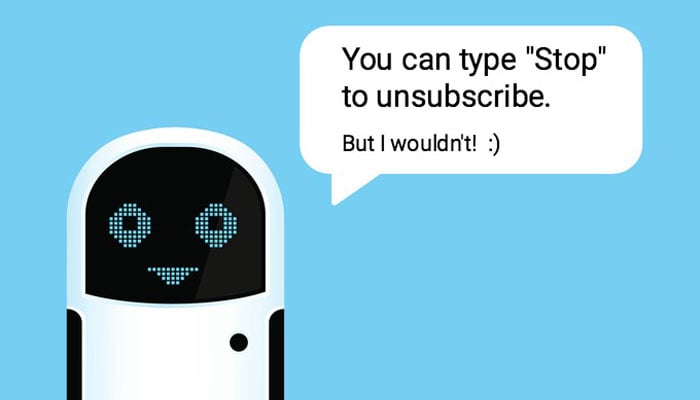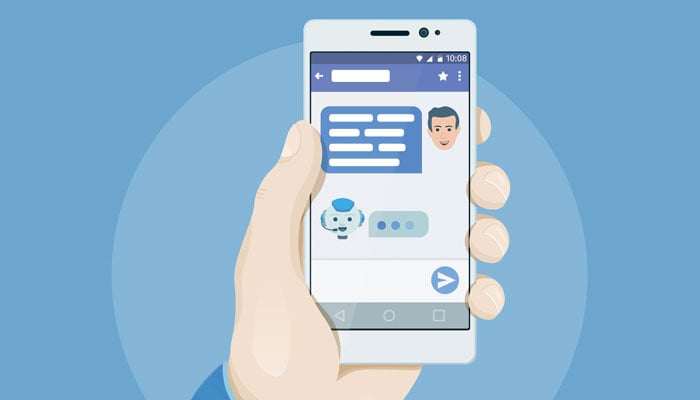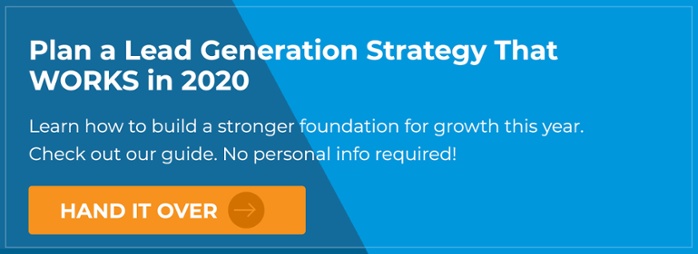
The Dos & Don’ts of Using Chatbots for B2B Lead Generation
Patrick Dodge
Founder
The marketing world has gone nuts over chatbots.
Everybody is talking about their potential for B2B lead generation, and some are pointing to the tool as a sure sign email marketing is on its way out.
I talked to a few recognized experts who completely disagree with that assessment, as they talked to me about some best practices they discovered after extensive experimentation and testing with bots.
An Interview with Dana Tran and Angelo Sorbello
Dana Tran is a Digital Coach who specializes in teaching entrepreneurs how to build a Messenger Bot without any coding. Her background was in IT and HR training and development before she founded Thinktuitive, an online education center about Messenger bots. Her article comparing ManyChat and Chatfuel has driven so much traffic to her website that Social Media Examiner recently featured her in their podcast and blog.
Angelo Sorbello specializes in lead generation and customer acquisition for businesses without using paid ads. He started his first online marketing business at age 13, and now runs a highly successful marketing agency.
When he first heard of chatbots Angelo was reluctant to even bother with them, thinking they were just the next “shiny object” for marketers. Then, a colleague told him about the great results they’d been getting from bots, and Angelo decided to go all in, learning everything he could by testing different strategies.
Both experts offer free resources that will help you learn more about chatbots. You can find them at the end of this article.
How to Integrate Chatbots into Your Lead Generation Strategy?
Even though they’ve only been mainstream for a relatively short time, chatbots are not especially hard to set up. The real challenge, according to Sorbello, is writing effective copy that keeps your prospects engaged.
“It’s great for lead nurturing. It’s a highly efficient way to deliver content and get to know your customers better,” he says. “The real struggle is with copywriting. If you focus on creating quality interactions, people will reply, and that gives you a great opportunity to learn about their needs better.”
Dana Tran agrees. She also suggests using chatbots to drive small actions that guide users to helpful information you already have on your website. “You can also prompt users to take small actions, like getting them to follow you on Twitter or subscribe to your YouTube channel.”
Getting these “micro-commitments” from users throughout each interaction is very important. It allows people to control the conversation, as your bot gives them little prompts to uncover to their needs.
Will Chatbots Replace Email Marketing?
Both Sorbello and Tran are quick to dispel the idea that chatbots will replace email marketing.
“People are saying chatbots are going to replace email marketing, and I don’t think that’s the case at all,” Sorbello says. “For years, people have been looking for something to replace email. I don’t think chatbots are the answer, but it is a powerful way to enhance the customer experience.”

Tran points out there are other important differences between the two channels that will have a big impact on your approach.
“With email marketing, open rates are lower, but there aren’t as many rules you have to follow. With Messenger bots, there are big restrictions companies needs to follow. For instance, even if somebody opts in for coupons or discounts, Facebook will not allow you to send out announcements that include these offers if the user has not interacted with your bot during the past 24 hours.”
Tran says it's important to know and follow the rules, or you could get your bot banned. Another important distinction is that, unlike email, chatbots are not “owned media.” Facebook could make a decision tomorrow that will have a huge impact on the data you have access to, along with other rules or limitations pertaining to bot interactions. Email, on the other hand, is a much more stable and flexible channel.
Here are a few other important considerations on using email and chatbots to enhance the user experience:
Chatbots are a Two-Way Street
According to Sorbello, chatbots are not a good push-marketing tool for broadcasting messages to prospects and customers. Instead, you should focus on simple interactions that help you learn about their needs and deliver value to them.
Leverage the Strengths of Both Channels
Tran advises marketers to think carefully about the culture of the two channels when planning a strategy. Copying and pasting your email message into a chatbot is a cardinal sin.
“When was the last time you bothered to read a 500 word text message from a friend or family member?” she asks.
Good point. She says email is best for delivering a lot of content at once, and then sending the user to your website to read more. Messenger can do the same thing, only with shorter, quicker bursts of information, using a more interactive medium, coupled with small “asks” that get permission from the user to send more.
Effective Copywriting is Critical
We’ve talked for years how important it is to connect with people on a personal level in our brand messaging. Sorbello says this need is absolutely essential if you want to succeed with chatbots.
“The key is you have to actually write as if you were chatting with a friend and having a friendly conversion in Messenger,” he says. “Copywriting is going to be much more important in the future.”
Copying and pasting your email message into a chatbot is a cardinal sin.“When was the last time you bothered to read a 500 word text message from a friend or family member?” she asks.
Which Bot Platform is Better?
The market is getting bigger for chatbots, and marketers have many choices for platforms to build them on.
The biggest ones Tran and Sorbello talked about were ManyChat, Chatfuel, Drift, and FlowXO, to name a few. ManyChat and Chatfuel run on Facebook Messenger, whereas other options like Drift allow you to run the bot on your website.
Tran smartly points out that Messenger chatbots are the most versatile because so many people have the app on their phones. With Messenger, customers can start a chat with you while working on their laptop at work and continue on their phones later on at the grocery store. You lose some of that flexibility when the bot lives on other apps.
At this time, none of the mentioned platforms allow you to funnel subscriber insights into your CRM, although Tran says tools like Zapier can help you do that.
Capture Insights With Chatbots, Not Just Leads.
This is one of the most important lessons Sorbello learned while experimenting with bots. He says the greatest potential lies in qualifying and nurturing customers – not just lead generation.
Think about how much time and effort it takes to get the insights needed to deliver a qualified lead to your sales team. Most of the time, the process begins when a visitor fills out a form, and then we follow up get more insights into that person’s needs.
A chatbot, on the other hand, can help you start learning about a prospect within seconds of your first interaction. By asking the right questions, you can start qualifying the prospect.
Can You Over-Automate Your Bot?
HubSpot recently remarked that automated phone menus really were the beginning of chatbots.
This is one of the first examples of people choosing their own informational path when interacting with a brand. Phone menus can be useful, but when they go on too long, they can be incredibly annoying.
Is there a risk of over-automating your bot, where customers are facing one pre-programmed question after another?
Tran says there isn’t much of a risk right now because bots are just not that smart. “How often have you asked Alexa or Siri a question and it doesn’t understand you?”

It’s true. As long as bots don’t understand natural language well, Tran says you still need a human being on the other end of the conversation. Still, she says bots play an important role for providing context to human-to-human interactions. For instance, if a customer tells your bot about a specific challenge, that information can be saved and referred back to when the bot follows up later on, asking “Hey, there. Did you get that issue resolved?”
“So, in terms of the right number of questions or messages in a sequence, it depends on a case to case basis,” Tran says, “but just always ask yourself, if people made a mistake on a question, what happens? Would the user be willing to start again from the beginning? And if the answer is no, then you should include fewer questions.”
Sorbello says he limits most sequences to no more than three to five messages before introducing the main call-to-action. “Soft-selling works way better with chatbots,” he says. “Some companies connect prospects to a live sales person immediately. Others don’t. It really depends on your industry and audience.”
Tran has a similar philosophy. “Some people are sending 3-5 messages a week. Some send one a day. I personally send out one or two a month. It’s still so new there’s no golden rule. As long as the user knows and opts in to receive those messages on a specific frequency, then you’re okay. I always try to let users know how often I’m going to be contacting them when I ask if they want to subscribe. Because with messenger bots, you’re not only using conversational marketing, but you should also be applying permission-based marketing too.”
How Can We Stop Marketers from Abusing Chatbots?
Show me a good marketing tactic, and I’ll show you one that’ll be ruined within a couple years.
Marketers will try to game anything they get their hands on. So, how can we keep ourselves in check and avoid annoying visitors?
Sorbello says a little common sense goes a long way. “Don’t be pushy,” he says. “Like we said before, it’s a two-sided platform. There’s not a lot of research about how people want to use chat right now, but I’ve seen surveys that say more than half of the consumers out there would rather use chat than call customer service, and people are more likely to shop from a business they can message.”
Tran says the greatest mistake people make is trying to copy their email marketing strategy with bots. “Frequency, copywriting, strategy – all of it,” she says. “The rules on Messenger are different. Don’t copy and paste your emails. It’s the worst thing you can do.”
It’s best to remember the reason people use chatbots in the first place – to get fast answers to their questions. If you lead the interaction from a customer service angle (ie. trying to help them) rather than sales and marketing, you are going to offer a much better experience.
“Instead of putting all that information into an email, you can break it down in a text and serve it to them in bite size pieces, based on their response,” Tran says. “Don't just spam them with a bunch of information and hope that they find the right point that matters to them. Use bots to guide users to the right information, product or service.”
How Can Marketers Increase Their Chatbot Subscribers?
Everyone wants to grow their audience, but Tran says focusing on the number of subscribers is really not the best way to go.
“My approach is about the quality of leads rather than quantity. Would you rather have 10,000 subscribers who are not the right fit for your product or service or a thousand of subscribers who you know are the right fit?” she asks. “I see a lot of people making it hard for a user to unsubscribe from the bot, just because they want to hold on to that person and say, oh I have 10,000 subscribers. But what does that number really mean? Why hold on to somebody that doesn’t want to be in a relationship?”
Quality wins over quantity every time.
How to Create a Flowchart for Your First Chatbot
Sorbello advises us to start by delivering a high value piece of content, like an ebook or whitepaper, then come up with a fun, engaging message that asks a question and tells them how often you plan to keep in touch.
“Educate and deliver value to them. It could be daily tips, or the latest amazing content that I just put out. I would make sure I’m asking qualifying questions and segmenting subscribers. Always add ‘user attributes’ to all the interactions, then soft sell in an educational context.”
Tran tells us to start by finding any repetitive task you want to automate (and doesn’t require a human).
“Start small, and add features later. You can also use a simple flow chart tool, like Lucid chart. I actually gravitate toward using my iPad and pencil, or pen and paper, and just quickly draw out the flow freehand. But at the end of the day, you just need to make sure you have a plan that’s directly tied to a business objective. Your bot should help users solve a specific problem. Ask yourself why should people visit and revisit your bot? Focus on that.
The biggest takeaway I got in my discussions with Tran and Sorbello boiled down to one thing: Respect.
Respect the platform and the audience. Make your bot conform to the way people want to communicate and make sure you are deliver real value to them. Everything else is a secondary consideration.
If you want to learn more from these two masters of bots – and I highly recommend you do – Angelo Sorbello just published one of the most comprehensive guides I’ve ever seen on this topic, titled The Ultimate Guide to Messenger Marketing and Facebook Chatbots.
Dana Tran recently released a series of online courses covering all of the Bot Essentials, including one for ManyChat and one for Chatfuel. In it, you’ll learn the basics of building a bot, segmenting user information, designing sequences, and promoting your bot. She also has a free mini-course called Bots 101 to help you get started with Messenger Bot.
She was also recently featured on the Social Media Examiner podcast and blog.
Thank you, Dana and Angelo, for sharing your amazing insights and demystifying the process a bit. It’s pretty easy to set up a chatbots. The hard part is keeping from adopting bad habits that will ultimately hurt our efforts.
Apr 13, 2018 12:30:52 PM

